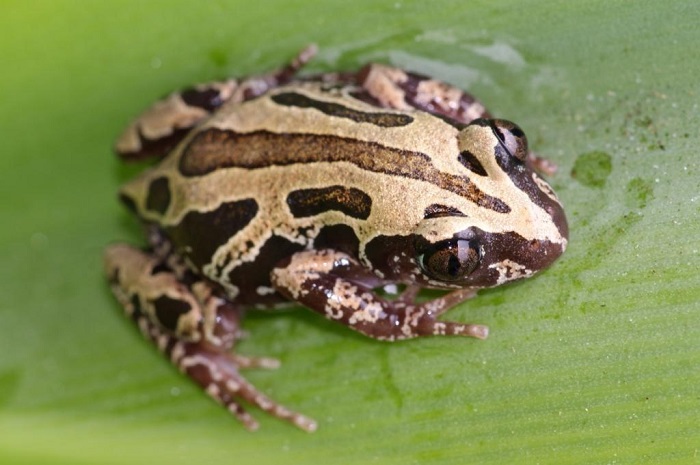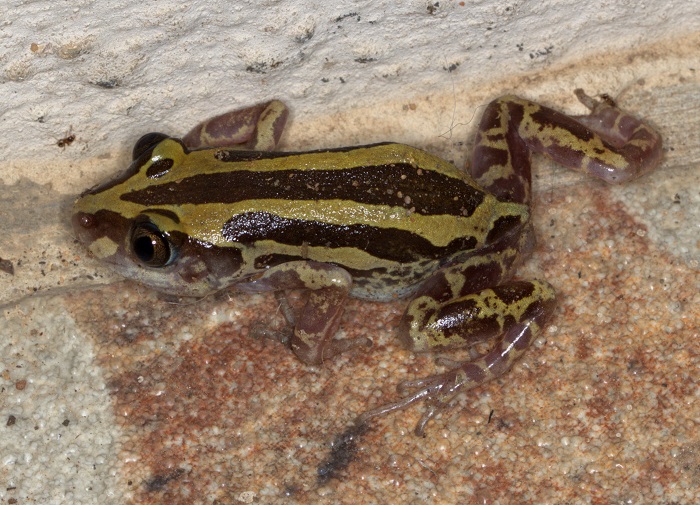View the above photo record (by Johan Heyns) in FrogMAP here.
Find the Bubbling Kassina in the FBIS database (Freshwater Biodiversity Information System) here.
Family Hyperoliidae
BUBBLING KASSINA – Kassina senegalensis
(Duméril and Bibron, 1841)
Habitat
K. senegalensis inhabits a wide variety of vegetation types in the Savanna and Grassland biomes (Poynton 1964; Balinsky 1969; Passmore and Carruthers 1995). Breeding habitat comprises both temporary and permanent water bodies, including well-vegetated shallow pans, vleis and marshes, as well as deeper dams (Rödel 2000).
Behaviour
During the dry season, K. senegalensis aestivates under logs and rocks and inside termitaria and burrows of the Giant Girdled Lizard Cordylus giganteus. Individuals were found as far as 1200 m from an ephemeral pan, at the end of the breeding season when the frogs moved away from the water to seek shelter for the winter (Kok et al. 1997).

Photo by J.K. Boyce
Breeding takes place from spring to late summer. During the day, adults hide under vegetation or rocks, or in burrows, emerging in the late afternoon to make their way to the breeding site. They begin to call at dusk while some distance from the water, before taking up positions near the water’s edge, well concealed beneath vegetation (Fleischack and Small 1978; Rödel 2000). In wet weather, calling takes place during the day as well as at night. The vocal repertoire includes an advertisement call as well as a longer, pulsed, territorial call (Fleischack and Small 1978).
Amplexus is usually initiated out of the water. Between 100 and 500 eggs are laid singly in shallow water; they are adhesive and may stick to submerged vegetation, rocks or other objects, or sink to the bottom. One amplexed pair dispersed their eggs over a distance of 3 m, depositing 1–15 eggs at a number of sites c.30 cm apart (Fleischack and Small 1978). The eggs are 1.4–1.8 mm in diameter, in 3-mm jelly capsules, and they hatch within 5–6 days. The tadpoles develop slowly and complete their development in 52–90 days (Wager 1965; Balinsky 1969). Rödel (2000) presented a detailed description of the life history of K. senegalensis and a comprehensive review of pertinent literature.

Photo by Luke Verburgt
K. senegalensis preys on a variety of arthropods, including termites, caterpillars, ants, flies and spiders (Loveridge 1936; Inger and Marx 1961). The species has been observed to fall prey to the Herald Snake Crotaphopeltis hotamboeia while approaching breeding sites. (C.W. and L.H. du P. pers. obs.).
Status and Conservation
This widely distributed and abundant species does not require conservation attention. The large number of farm dams that have been built in South Africa have created additional breeding habitat for this species. K. senegalensis is recommended as a research subject because of its wide distribution, abundance, and the ease with which it may be kept in captivity (Van Wyk et al. 1992).

Photo by Luke Verburgt
Distribution
K. senegalensis is one of the region’s most widely distributed frog species, occurring throughout almost all of sub-Saharan Africa. It is found in suitable habitats at low and high altitudes, from Senegal in West Africa, eastward to Somalia and southward to South Africa. In the atlas region, this species is common in all provinces except Western Cape Province (apart from one record), the western part of Eastern Cape Province and the central and western parts of Northern Cape Province. It occurs throughout Swaziland, and its apparently sparse distribution in lowland Lesotho reflects inadequate sampling rather than a real absence of the species. It is certainly one of the most common species in the atlas region, within the limits of its range.
The data set is reliable and fairly comprehensive, especially as the characteristic call, an explosive, short “boip”, reveals the presence of the species from great distances and clearly distinguishes it from all other species.

Further Resources
Virtual Museum (FrogMAP > Search VM > By Scientific or Common Name)
More common names: Borrelvleipadda (Afrikaans)
Recommended citation format for this species text:
Weldon C, du Preez LH, Tippett RM. Bubbling Kassina Kassina senegalensis. BDI, Cape Town.
Available online at http://thebdi.org/2022/01/07/bubbling-kassina-kassina-senegalensis/
Recommended citation format:
This species text has been updated and expanded from the text in the
2004 frog atlas. The reference to the text and the book are as follows:
Weldon C, du Preez LH 2004 Kassina senegalensis Bubbling Kassina. In Minter LR
et al 2004.
Minter LR, Burger M, Harrison JA, Braack HH, Bishop PJ, Kloepfer D (eds)
2004. Atlas and Red Data Book of the Frogs of South Africa, Lesotho and
Swaziland. Smithsonian Institution, Washington, and Avian Demography
Unit, Cape Town.

